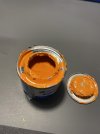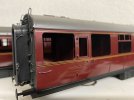Heather Kay
Western Thunderer
Some time ago, one of the WT members was clearing his storage and came across three partly-built Sparmac coaches. Not having any use for them, he posted them for sale, and I couldn't resist. Another member said he'd like to buy them when I'd finished them, so they arrived in my lengthy build queue.
For those that don't know, Sparmac kits were early resin kits, very similar to the later JLTRT stuff. The models I bought were pretty much assembled. They just needed to be completed, painted and away they could go. Early on I decided to treat the models to decent underpinnings, and attempted to acquire a set of Kemilway etched bogie kits. The build thread has the tale of woe, so let's just say we live in hope of the final 8ft heavyweight bogie appearing one day. Until then, the full brake has been equipped with rather untidy MM1 (ex-JLTRT) cast whitemetal jobs.
The full build thread is on this link.
So, to the gallery shots.



Diagram 113 Full Brake, E70163, built Doncaster 1929, withdrawn June 1965. One end has been given detailing on the headstock, with dropped knuckle coupler and the buffers extended with the collars fitted. Like the other coaches, I decided to fit modified Slater's SR Pullman gangways rather than use the rather ropey rubber efforts that came in the kits.



Diagram 114 Brake Third Corridor, E16248, built Birmingham 1930, withdrawn March 1962. Aside from bogies and gangways, the kits were pretty complete. I added some internal detail to the full brake and brake third guard's compartments. It is quite surprising how much can be seen peering through the windows. Coupling between coaches is by Kadee knuckle couplers, with only the outer end of the full brake being detailed in any way.


Diagram 115 All Third Corridor, E12264, built York 1929, withdrawn January 1962. With the help of @Mike Trice I modified roof details, worked out the toilet filler pipes and passenger communication pipework, and sourced clear images of the seat moquette so I could recreate it more or less at scale.
Getting the lining to run neatly along the beading proved a trial. The end result is far from perfect, but there came a point where I was going round in circles and had to stop! The finished coaches are imposing models and do look rather smart in their clean BR maroon livery. I haven't weathered above solebar level, knowing the client may prefer to weather to his own tastes.
Thanks, as ever, to everyone that followed the build process, and helped with research and information.
For those that don't know, Sparmac kits were early resin kits, very similar to the later JLTRT stuff. The models I bought were pretty much assembled. They just needed to be completed, painted and away they could go. Early on I decided to treat the models to decent underpinnings, and attempted to acquire a set of Kemilway etched bogie kits. The build thread has the tale of woe, so let's just say we live in hope of the final 8ft heavyweight bogie appearing one day. Until then, the full brake has been equipped with rather untidy MM1 (ex-JLTRT) cast whitemetal jobs.
The full build thread is on this link.
So, to the gallery shots.


Diagram 113 Full Brake, E70163, built Doncaster 1929, withdrawn June 1965. One end has been given detailing on the headstock, with dropped knuckle coupler and the buffers extended with the collars fitted. Like the other coaches, I decided to fit modified Slater's SR Pullman gangways rather than use the rather ropey rubber efforts that came in the kits.


Diagram 114 Brake Third Corridor, E16248, built Birmingham 1930, withdrawn March 1962. Aside from bogies and gangways, the kits were pretty complete. I added some internal detail to the full brake and brake third guard's compartments. It is quite surprising how much can be seen peering through the windows. Coupling between coaches is by Kadee knuckle couplers, with only the outer end of the full brake being detailed in any way.

Diagram 115 All Third Corridor, E12264, built York 1929, withdrawn January 1962. With the help of @Mike Trice I modified roof details, worked out the toilet filler pipes and passenger communication pipework, and sourced clear images of the seat moquette so I could recreate it more or less at scale.
Getting the lining to run neatly along the beading proved a trial. The end result is far from perfect, but there came a point where I was going round in circles and had to stop! The finished coaches are imposing models and do look rather smart in their clean BR maroon livery. I haven't weathered above solebar level, knowing the client may prefer to weather to his own tastes.
Thanks, as ever, to everyone that followed the build process, and helped with research and information.
Last edited:



